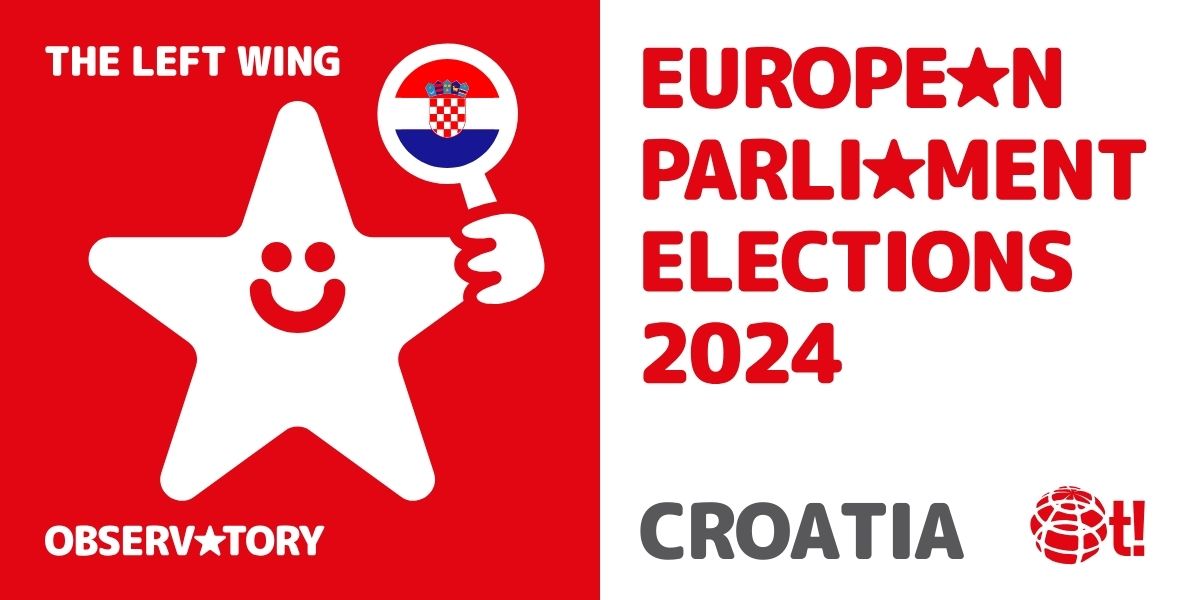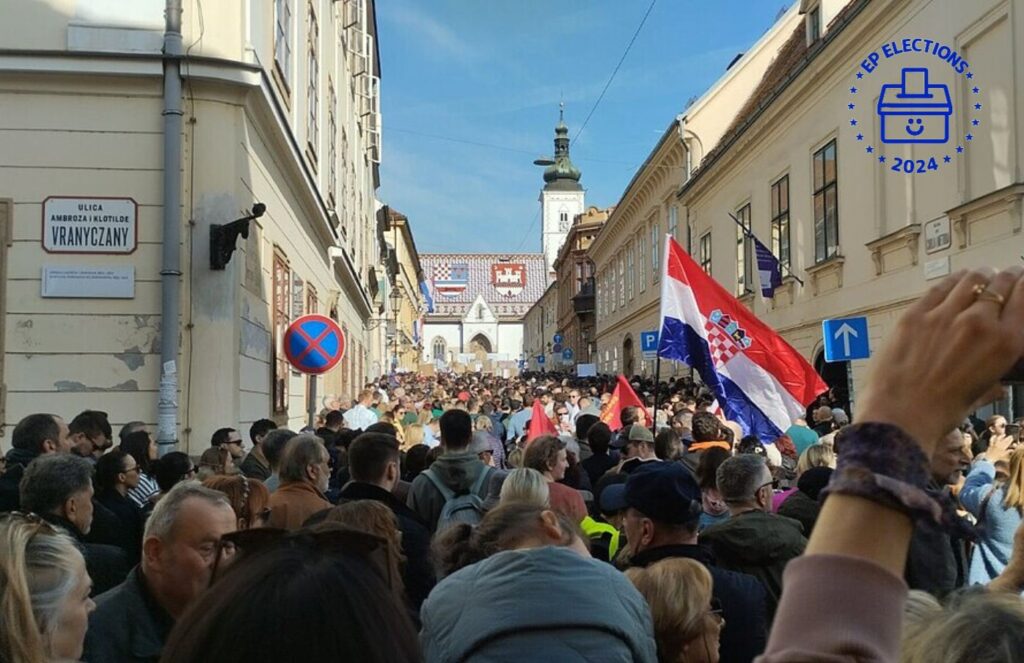
Ahead of the European Parliament elections, Croatia finds itself caught between the ever-ruling HDZ party and the ascending extreme right. This might result in voter apathy on election day.
Croatia has had a low turnout in elections for the European Parliament since the very beginning: in 2013, only 21% of voters turned out to elect the twelve Croatian representatives at the European Parliament who served the remainder of the 2009-2014 term after Croatia entered the EU. One year later for the next election, Croatian turnout was 25%, and, in 2019, slightly less than 30% — whereas EU average turnout in the 2019 election exceeded 50% for the first time in history. What might we anticipate in this regard in 2024? There are two possible scenarios.
Either the recent intensity of the political campaign for the national elections held in April 2024 will carry over to the coming European elections. This would result in a large turnout and the eventual rise of some new and fresh political forces as a positive development. Or there is the other scenario: the increased voter turnout in the April parliamentary elections (62,3%; nearly 15% higher than in the preceding elections in 2020) may result in a kind of anticlimax. Left-leaning citizens may feel disillusioned and hence refrain from voting in the European elections, because despite high voter turnout in April, they were unable to remove the ever-ruling HDZ from power. As for the voters on the right side of the electoral spectrum, they are traditionally less interested in common European values, and consequently in European elections, because their ideology is based on euroscepticism. And there is always a large number of politically passive citizens who believe that elections (whatever they are) won’t change anything.
A Stabilitocratic Model
Yet, if we can’t really predict voter turnout, we still can anticipate the final outcome of the European elections. Before we get into our forecast about the future distribution of Croatian mandates at the European Parliament, let’s look at how Croatian politics has developed over the past three and a half decades. Croatian political culture appears to have been very consistent (not to mention predictable) from the time of independence till the present. We may say that Croatia has evolved into something resembling bipartisanship, but only to some extent: two parties indeed alternated on the winning political pedestal over the whole period, the HDZ (Croatian Democratic Union) and the SDP (Social Democratic Party). However, bipartisanship does not define really the national political configuration, as the HDZ won nine elections from 1990 to 2024, and the SDP only two (2000 and 2011). So, we can talk about a very unbalanced two-party system, with a strong bias towards one side. The victory of the HDZ in the latest national elections resulted in a new four-year mandate, which means that the Christian democratic party will rule for exactly thirty of the 38 years of multi-party rule in Croatia. However, Croatia is not an exception in this regard, and we have seen many parliamentary democracies dominated for years by one single party. A classic example is Mexico, where one party ruled for decades, and an example closer to us is Italy, where the Christian Democracy ruled from the end of World War II until the beginning of the 1990s.
Recently, a new analytical framework has appeared which claims that from 1990 to 2020, a type of stabilitocracy (sometimes also called stabilocracy) reigned in Croatia. Dragan Bagić, Professor of Sociology at the Faculty of Philosophy in Zagreb, who has been promoting the publication Croatian voters: 30 years of political behavior and opinion published by the Faculty of Political Sciences in Zagreb, remarked1 that: “We need a study on the HDZ… This is not a joke. We can’t understand this stability unless we understand the HDZ. This is the gravitational force of Croatian political space.” All this should not be surprising. Political analyst Florian Bieber claims that stabilitocracy has been reigning in the Balkans for a long time. Furthermore, Croatia, together with Serbia, is the originator of the so-called “Balkan stabilitocracy”. Bieber adds2: “Stabilitocracies have their regional antecedents in the 1990s, when both the governments of Franjo Tuđman in Croatia and Slobodan Milošević in Serbia received temporary endorsements by external actors in exchange for the offer of stability.” The European political and business center (the so-called “external actors”, or Bruxelles, in lay terms) seeks and finds on its semi-periphery among Croatian political elites, particularly the HDZ, that type of political partner able to maintain political stability in the country for, among other things, unrestricted, unhindered and smooth investment. For such a mild business climate, we, here in Croatia, paid a very high price. In exchange for that level of stability, we got: endemic corruption, controlled media, and weak opposition. During all that period, nationalism remained strong, as did the anti-minority attitude, while xenophobia has been on the rise, and the quality of life has remained stagnant. Analyst Dario Čepo describes3 Croatia as “a run-of-the-mill stabilitocracy” and, in that sense, “Croatia is neither a special case nor a poster child of European integration”.
Given this, it is reasonable to predict that the HDZ will either win the upcoming European Parliament elections or share mandates with the SDP, as they did in the previous elections five years ago, when the HDZ won four of the 12 mandates and the SDP also four (2019), while the rest were split between independents and small parties. Five years earlier, the HDZ had gained five mandates in European Parliament, while the SDP and coalition parties had received four.
Emergence of Two New Powerful Players
What is new, however, is the emergence of two relatively new powerful players in domestic politics.
The green-left platform Možemo (We Can!) was established a few years ago by a number of tiny left-wing and environmental parties, as well as civic initiatives. Their base is Zagreb: For the past three years, Zagreb has been ruled by Možemo, the mayor and the city administration have been working tirelessly to meet urgent local needs, achieving previously unimaginable feats in this regard. In the recent national elections, the platform increased its seats in the national parliament, from five to ten. They are supported by young individuals with higher education levels, particularly those who are dissatisfied with the old traditional Social Democrats (SDP). Furthermore, Možemo addresses whole new societal issues, such as housing affordability, sustainable development, de-growth policy, and green policies, which are not discussed (or only briefly and superficially) in other political parties’ proposals. Currently, Možemo has no MEPs in the European Parliament. Therefore, it is quite realistic to expect their strong showing in the European elections, as well as one or two seats in the next Parliament.
The second “new” player is DP (Domovinski pokret-Homeland Movement), an extreme right-wing organisation founded four years ago. It brings together individuals who are unsatisfied with current pro-Bruxelles politics and has its roots in the HDZ of 2016, when the party was led by Tomislav Karamarko: When Karamarko fell politically, the most extreme elements of the party abandoned the HDZ. Their main strength is anti-Serb politics and political rhetoric, demanding the removal of all Serbian political representatives from all governmental offices. They also demand that Novosti, a weekly newspaper published in Zagreb by the Serb National Council, be shut down. Despite the HDZ’s “treacherous” pro-Brussels agenda under President Andrej Plenković, the DP party, which became the third largest faction after the April election and as such a “king maker”, sought the HDZ to form the new government. Plenković, the current leader of the HDZ, represents the party’s moderate, pro-European faction. The question is whether the compromises that the DP will be forced to make will decide the coalition’s fate (they already had to give up taking over the department of culture and deratifying the Istanbul Convention, etc.), that is: how long it will last. Many hopes, as short as feasible.
That would be the main overview of today’s politics in Croatia. Understanding the rise of the radical-right DP is critical to accurately assessing Croatian politics today. It is so hard to believe that today, after joining the European Union, entering the Schengen zone, and accepting the common European currency, we have a government in which one coalition member threatens minorities, newspapers, women, migrants, anti-fascists, and others who are on their way to being excluded from social flows. Frankly, there is barely any reason to presume that the European Parliament elections and their outcome (whatever the result may be) would improve this bleak, dreary, and grim picture of today’s Croatia.
References
[1] “Hrvatski birači – Što se promijenilo u 30 godina?”, Tportal.hr, 23/05/2024
[2] “The Rise (and Fall) of Balkan Stabilitocracies”, by Florian Biber, CIRSD, 2018, N°10
[3] Heinrich Böll Stiftung, Southern Europe, Perspectives N°7, Nov 2019
Cover photo: Protest “Enough is enough! Elections now” (“Dosta je! Odmah na izbore”) in Zagreb on 17 February 2024 (against the Croatian government and the HDZ, organised by eleven opposition parliamentary parties). Photo by Franjo Tahy via Wikipedia (CC0 license).



